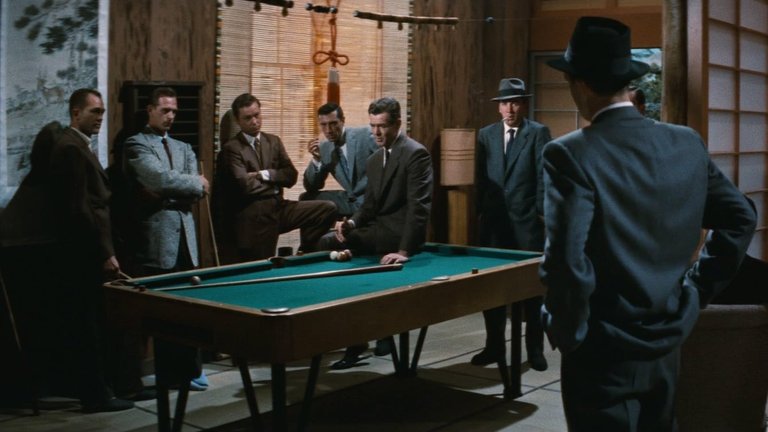
When Hollywood remakes films, particularly when it occurs just a few years after the original, it is essential to infuse the second adaptation with distinctiveness. Thankfully, this was achieved with the 1955 film House of Bamboo, an intriguing adaptation of the 1948 crime film The Street with No Name. Director Samuel Fuller's involvement resulted in one of his more notable works, showcasing a unique blend of crime, intrigue, and exotic locales.
The film transports viewers to 1954 Japan, where a group of masked assailants robs a train carrying U.S. Army supplies, resulting in the death of a U.S. serviceman. This incident prompts a joint investigation by the Japanese police and the U.S. military. The robbery's true purpose is revealed during the later heist, when some of the equipment used by criminal. One of the participants, American named Webber (played by Biff Eliott), is mortally wounded by his own accomplices. During his interrogation on his deathbed, Webber refuses to divulge the identities of his associates but confesses to being secretly married to a Japanese woman named Mariko Nagoya (played by Shirley Yamaguchi). Subsequently, Mariko is visited by Eddie Spanier (played by Robert Stack), an American who claims to be an old friend of Webber's and an invited participant in his, apparently criminal, endeavours. His attempts to establish protection racket over Tokyo pachinko parlours fail, but audacity bring attention of Sandy Dawson (played by Robert Ryan), leader of gang made of former US military servicemen, who has Spanier recruited into his organisation. However, Spanier is actually Sergeant Edward Kenner, a U.S. military investigator working undercover.
House of Bamboo not only shifted the setting from an unnamed U.S. city in the original but also boasted a different aesthetic and visual approach. The film's adoption of the Cinemascope widescreen format and bright colour cinematography stood out, deviating from the semi-documentarian style of the 1948 black-and-white film. Fuller embraced a more conventional narrative structure while still capitaliaing on the opportunity to shoot in authentic Japanese locations. This decision yielded a visually captivating film that also provides an insightful glimpse into Japan a decade after the devastation of World War II and at the onset of its famed post-war economic miracle. Tokyo is portrayed as a bustling, Western-like metropolis, yet the film still showcases people, particularly women, wearing traditional attire. The use of daytime scenes eliminates the neon-lit panoramas that would later become synonymous with the city, offering a unique perspective on the rapidly changing Japanese landscape.
However, the change of setting to more exotic Japan came at the expense of the plot's plausibility. The idea that a group of Americans, who would naturally attract too much attention due to their appearance, could build and maintain a gangland empire in Japan similar to those in the United States seems implausible. This may not be a concern for older generations, but younger viewers more accustomed to the portrayal of Japanese yakuza in modern culture may find this aspect of the film difficult to swallow.
Samuel Fuller, who co-wrote the film with Henry Kleiner, author of the 1948 script, was more interested in exploring themes of culture clash and racism. Some critics and film scholars view the film as an allegorical condemnation of U.S. imperialism, with Sandy and his gangsters serving as a substitute for the wrongs the United States had committed in the post-WW2 world.
Fuller was more explicit in subverting U.S. racism, which had previously been reflected in the infamous MPAA Production Code banning Hollywood films from portraying interracial romances. Fuller enthusiastically embraced the recent removal of these censorship standards, and the characters of Eddie and Mariko fall in love with each other.
Some may argue that this romantic subplot is too much of a concession to orientalist stereotypes of the U.S. and Western audience, while others may point out that it serves as a counterweight to the implicit homosexuality of Sandy's character, which can be found in scenes showing Sandy behaving strangely in the presence of Eddie and causing jealousy in his lieutenant Griff, played by Cameron Mitchell.
The acting in the film is solid, with Robert Ryan leaving a better impression as the complex villain than Robert Stack as the conventional hero. Japanese actress Yuchiko "Shirley" Yamaguchi handles her potentially thankless role well. The cast also includes famous Japanese actor Sessue Hayakawa in a small role as a police inspector, while one of Dawson's men is played by DeForest Kelley of later Star Trek fame, who is virtually unnoticeable in pan&scan versions of the film shown on television.
Fuller directs the film with great skill, but the final showdown, obviously modelled on the grand finale of *White Heat *, is slightly overlong and sacrifices realism for the sake of spectacle.
House of Bamboo, despite its flaws, deserves recommendation as one of the more ground-breaking films in the career of Samuel Fuller, which has set his path towards becoming a great independent author of American cinema.
RATING: 6/10 (++)
Blog in Croatian https://draxblog.com
Blog in English https://draxreview.wordpress.com/
InLeo blog https://inleo.io/@drax.leo
Hiveonboard: https://hiveonboard.com?ref=drax
Rising Star game: https://www.risingstargame.com?referrer=drax
1Inch: https://1inch.exchange/#/r/0x83823d8CCB74F828148258BB4457642124b1328e
BTC donations: 1EWxiMiP6iiG9rger3NuUSd6HByaxQWafG
ETH donations: 0xB305F144323b99e6f8b1d66f5D7DE78B498C32A7
BCH donations: qpvxw0jax79lhmvlgcldkzpqanf03r9cjv8y6gtmk9
Posted Using InLeo Alpha